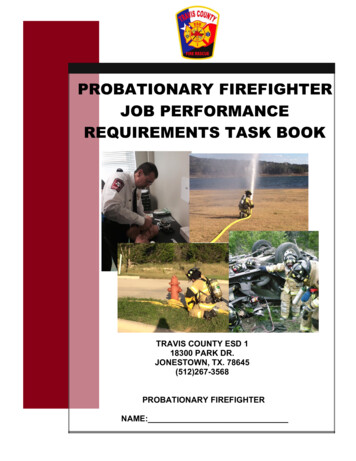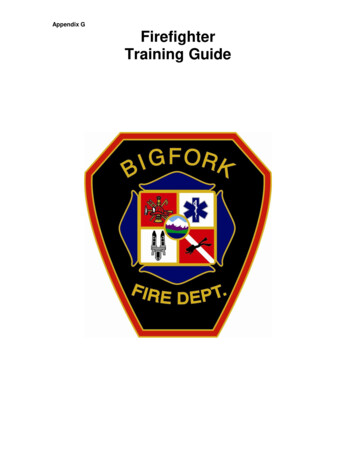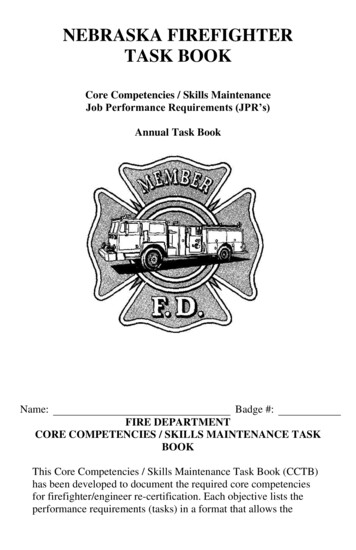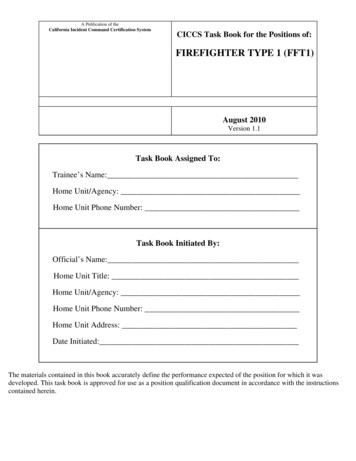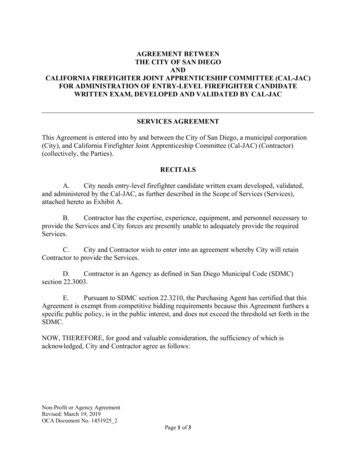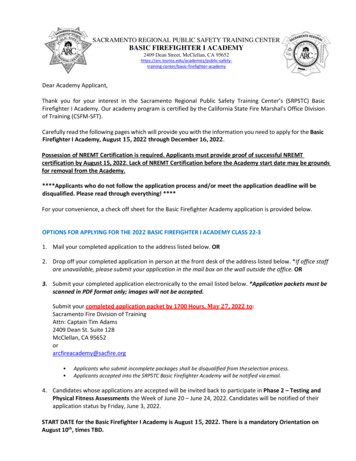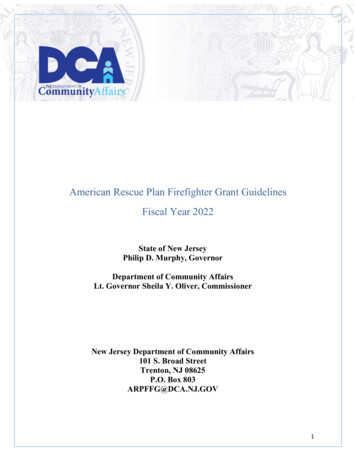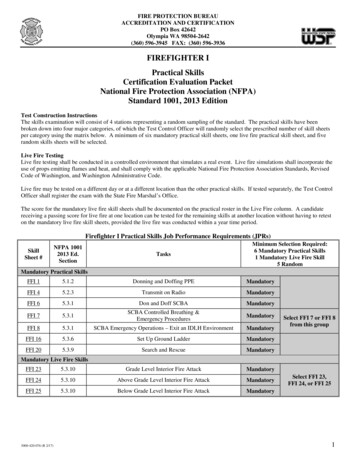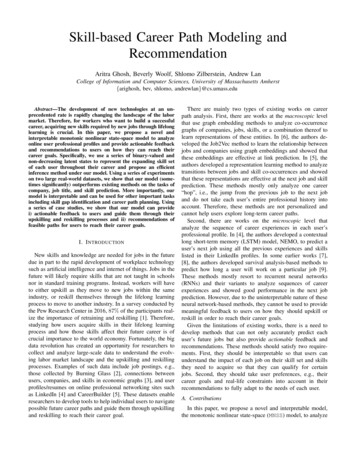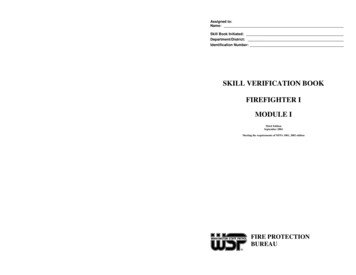
Transcription
Assigned to:Name:Skill Book Initiated:Department/District:Identification Number:SKILL VERIFICATION BOOKFIREFIGHTER IMODULE IThird EditionSeptember 2004Meeting the requirements of NFPA 1001, 2002 editionFIRE PROTECTIONBUREAU
INSTRUCTIONS: This book will be used to verify training in theprerequisite skills that are necessary before reimbursement for trainingand/or a certification test for Fire Fighter I, Module I.When the skill is mastered, it will be initialed and dated by theresponsible authority for verification; any person who initials asubject must also place his/her name, position, and initial in theverifier portion of the booklet.This booklet may be used as satisfying prerequisite training whenundertaking Fire Fighter I certification.NOTE: Text in italics is not a mandatory Fire Fighter I PerformanceTask. It is a suggested means of meeting the desired objective.Verification/Certification of Completed Task Book for Fire Fighter I,Module I (Basic Fire Fighter Training)FINAL EVALUATOR’ S PREREQUISITETASKS VERIFICATIONI Verify That All Tasks Have Been Performed ByTo Satisfaction at the Fire Fighter I LevelEvaluator’s Signature and DateEvaluator’s Printed Name, Title, Department, and PhoneNumberAGENCY CERTIFICATIONI Certify That the Above-Named IndividualSocial Security or Identification NumberHas Met to Satisfaction, All Prerequisite Task Requirements ForFire Fighter I, Module I (Basic Fire Fighter Training )Certifying Department Official’s Signature and DateCertifying Department Official’s Printed Name and TitleOfficial’s Department and Phone Number239
SKILL REQUIREMENTS5.1 GENERAL5.1.1.2General Skill Requirements And First Aid5.2 FIRE DEPARTMENT COMMUNICATIONS5.2.15.2.25.2.3Initiate Response to a Reported EmergencyUse of TelephoneTransmit and Receive Radio Messages5.3 FIREGROUND SCBA Use During Emergency OperationsResponding On Fire ApparatusForce Entry Into a StructureExiting Hazardous AreaSetting Up Ground LaddersSearch and Rescue in StructureClass A Interior Structure Fire (Partial)Perform Horizontal Ventilation on a Structure (Partial)Perform Vertical Ventilation on a Structure (Partial)OverhaulConserve Property as a Member of a TeamWater SupplyFire ExtinguishersIlluminate the Emergency SceneShutting Building UtilitiesCombat a Ground Cover Fire5.5 PREVENTION, PREPAREDNESS, ANDMAINTENANCE5.5.15.5.25.5.35.5.4Perform a Fire Safety Survey in a Private DwellingPresent Fire Safety InformationClean and Checking Equipment (Partial)Clean, Inspect, and Return Fire Hose to ServiceKNOWLEDGE REQUIREMENTSSame headings as Skill Requirements.VERIFICATION PAGE383
SKILL REQUIREMENTS5.1Names, Position, and Signed Initials of Verifiers:(Print Name and Position. Initial Same Way as WhenVerifying.)GENERALName5.1.1.2General Skill Requirements and First Aid –Has Demonstrated the Ability to:PositionDateInitialsPerformance SkillsDon personal protective clothing in 1 minute- Is able to don issued personal protectiveclothing in one minute. This will includehelmet, hood, coat, pants, boots, and gloves,with all fasteners closed.InitialsNameDoff personal protective clothing andprepare for reuse - Is able to remove thepersonal protective clothing used in the aboveskill and place it ready for reuse according todepartment SOPs.PositionBasic first aid and infection control - Haspassed a basic first aid course that meets therequirements for fire department personnel,WAC 296-305-01515.NameInitialsPositionInitialsCPR - Has received training and has a currentbasic CPR card.Hoist tools and equipment using ropes andthe correct knot - Is able to demonstratesecuring and hoisting firefighting equipmentsuch as an axe, pike pole, hose, etc., to a secondstory or roof.NamePositionInitialsTie the following knots: bowline, clove hitch,figure of eight on a bight, half hitch, becketor sheet bend, safety knot - Is able to performthe task.Locate information in departmentaldocuments and standard or code materials Is able to locate information such as SOPs,report sheets, etc., used by the department.4NamePositionInitials37
5.5.3DateClean and Checking Equipment (Partial) –Has Demonstrated Satisfactory Knowledgeof:InitialsPerformance SkillsThe types of cleaning methods for a SCBA.5.2FIRE DEPARTMENT COMMUNICATIONS5.2.1DateInitiate Response to a Reported Emergency –Has Demonstrated the Ability to:InitialsThe correct use of cleaning solvents if anyfor a SCBA.Manufacturer’s or departmental guidelinesfor cleaning a SCBA.Relay information - Is able to demonstraterelaying information necessary to departmentmembers for response.The types of cleaning methods for varioustools and equipment.Record information - Is able to demonstraterecording all information necessary for response toan emergency.The correct use of cleaning solvents.The manufacturer’s and departmentalguidelines for cleaning tools and equipment.5.2.25.5.4DateClean, Inspect, and Return Fire Hose toService – Has Demonstrated SatisfactoryKnowledge of:InitialsPerformance SkillsOperate fire department communicationsequipment - Is able to demonstrate operating allcommunication equipment used by the department.DateUse of Telephone –Has Demonstrated the Ability to:InitialsPerformance SkillsThe departmental procedures for notingdefective hose and removing from service.Performance SkillsOperate fire station telephone and intercomequipment - Is able to demonstrate operatingall telephone and intercom equipment used bythe department.Hose cleaning methods.5.2.3Hose rolls.Hose loads.DateTransmit and Receive Radio Messages –Has Demonstrated the Ability to:InitialsPerformance SkillsOperate radio equipment - Is able todemonstrate operating all radio equipment usedby the department.Discriminate between routine andemergency traffic - Is able to demonstrateroutine and emergency traffic and discriminatebetween the two types of traffic.365
5.3FIREGROUND OPERATIONS5.3.1DateUse SCBA During Emergency Operations –Has Demonstrated the Ability to:InitialsPerformance SkillsComplete SCBA donning procedures in oneminute - Is able to completely don the SCBAwithin one minute with all protective clothingin place, with pass device activated, and on air.Start with full protective clothing on, exceptgloves. The SCBA can be compartmentmounted, seat-mounted, in the case, or lying onthe floor in front of the person. It will have thestraps fully extended and in a ready state.5.5 PREVENTION, PREPAREDNESS, ANDMAINTENANCE5.5.1DatePerform a Fire Safety Survey in a PrivateDwelling – Has Demonstrated SatisfactoryKnowledge of:InitialsThe common causes of fire and theirprecautions.The importance of a fire safety survey.Public fire education program’s importanceto fire department public relations and thecommunity.Control breathing while using the SCBA - Isable to demonstrate controlled breathing,including skip breathing, while wearing theSCBA and on air.Initiate and complete emergency proceduresin event of SCBA failure or air depletion - Isable to demonstrate procedures for thefollowing: regulator failure, facepiece failure,out of air with no resupply available, and out ofair with full cylinder available.Use SCBA to exit through restrictedpassages - Is able, while wearing full protectiveequipment, to negotiate a restricted areawithout removing the backpack, or removingthe backpack staying on air and replacing thebackpack when through the restricted passage.Performance SkillsOrganizational policy and procedures.5.5.2DatePresent Fire Safety Information –Has Demonstrated Satisfactory Knowledge of:InitialsPerformance SkillsThe parts of informational materials andhow to use them.Basic presentation skills.Department SOPs for giving station tours.Replace SCBA cylinders - Is able to replace aSCBA cylinder on another person while theyare wearing the SCBA, and while the SCBA isnot in use.635
5.3.18 Turn Off Building Utilities –Has Demonstrated Satisfactory Knowledgeof:DateInitialsPerformance SkillsThe properties, principles, and safetyconcerns for electricity, gas, and watersystems.5.3.2DateRespond on an Apparatus to an EmergencyScene –Has Demonstrated the Ability to:InitialsThe methods for disconnecting utilities andpossible dangers associated with thesemethods.The safety equipment that should be usedwhen disconnecting utilities.5.3.19 Combat a Ground Cover Fire –Has Demonstrated Satisfactory Knowledge of:DateInitialsPerformance SkillsThe types of ground cover fires.The parts of ground cover fires.The methods to contain or suppress groundcover fires.Safety principles and practices.34Performance SkillsUse each piece of provided safety equipment- Is able to use the provided safety equipment,including, but not limited to, seat belts, noisebarriers, and other provided safety equipment.Demonstrate the proper hand signals usedwhen guiding apparatus.5.3.4DateForce Entry Into a Structure –Has Demonstrated the Ability to:InitialsPerformance SkillsTransport (carry) hand and power tools - Isable to correctly transport (carry) all hand andpower tools used for forcible entry by thedepartment.Operate hand and power tools - Is able tocorrectly operate all hand and power tools usedfor forcible entry by the department.Force entry through doors, windows, andwalls using assorted methods and tools - Isable to demonstrate forcing entry throughdoors, window, and walls present within thedepartment service area using departmentequipment.7
5.3.5DateExit a Hazardous Area as a Team –Has Demonstrated the Ability to:InitialsPerformance SkillsOperate as a team member in vision-obscuredconditions - Is able to function as a member ofat least a two-person search and rescue teamwhile searching in a vision-obscuredatmosphere, knowing when and how to exit theenvironment.5.3.15 Connect a Fire Department Pumper to aWater Supply – Has DemonstratedSatisfactory Knowledge of:DateInitialsFire hydrant operations.What are suitable static water supplysources.Locate and follow a guideline - Is able tolocate a guideline and determine how to use theguideline to exit to safety.Conserve air supply - Is able to demonstratecontrolled breathing and skip breathing toconserve the air supply while using a SCBA.Evaluate areas for hazards - Is able toevaluate areas for hazards to personnel, such asbuilding safety, fire hazards, and hazardousmaterials.Performance SkillsThe loading and off-loading procedures for amobile water supply apparatus.The procedures and protocol for connectingto various water sources.5.3.16 Extinguish Incipent Class A, B, and C FiresWithPortable Fire Extinguishers – HasDemonstrated Satisfactory Knowledge of:DateInitialsIdentify a safe haven - Is able to identify safeareas for personnel while conducting a searchsuch as exterior areas, interior locations that canbe secured from hazards, etc.Performance SkillThe classification of fire.The types of, rating systems for, and risksassociated with each class of fire.The operating methods of and limitations ofeach type of portable fire extinguishers.5.3.17 Illuminate the Emergency Scene –Has Demonstrated Satisfactory Knowledge of:DateInitialsPerformance SkillsThe safety principles and practices.The power supply capacity and limitations.Light deployment methods.833
5.3.13 Overhaul a Fire Scene –Has Demonstrated Satisfactory Knowledge of:DateInitialsPerformance SkillsThe types of fire attack lines and waterapplication devices most effective foroverhaul.Water application methods forextinguishment that limit water damage.The types of tools and methods used toexpose hidden fires.The dangers associated with overhaul.The obvious signs of area of origin or signsof arson.The reasons for protecting the fire scene.The purpose of overhaul.The indicators of hidden fires.5.3.14 Conserve Property as a Member of a Team –Has Demonstrated Satisfactory Knowledge of:DateInitials5.3.6DateSet Up Ground Ladders –Has Demonstrated the Ability to:InitialsPerformance SkillsCarry, raise, extend ladders, and lock flies Is able to safely remove all ladders used bydepartment from apparatus, carry to adesignated place, raise and secure flies (ifequipped).Determine that a wall and/or roof willsupport ladders - Is able to judge if a wall orroof is in a safe condition to support a ladderand the activities associated with its operation.Judge extension ladder height requirements- Is able to determine what ladders are neededfor the activity involved and where they need tobe placed for different situations such as rescue,ventilation, hose work, or other activities.Place ladder to avoid obvious hazards - Isable to place and raise a ladder to avoid obvioushazards such as electrical wires, branches, orother hazards.Performance SkillsThe purpose of property conservation and itsvalue to the public.The methods used to protect property.The types of and uses for salvage covers.Operations at properties protected withautomatic sprinklers.How to stop the flow of water from anautomatic sprinkler head.The identification of the main control valveof a sprinkler system.Forcible entry issues related to salvage.329
5.3.9DateConduct a Search and Rescue in a Structure –Has Demonstrated the Ability to:InitialsPerformance SkillsUse SCBA to exit restricted passages - Sameconditions as in 3-3.1.Set up and use different types of ladders forvarious rescue operations - Is able to placeladders used by the department for use duringrescue situations.Rescue a firefighter with functioningrespiratory protection - Is able to remove adisabled firefighter from a hazard area withoutcompromising their functioning respiratoryprotection.Rescue a firefighter whose SCBA is notfunctioning - Is able to remove a disabledfirefighter from a hazard area who does nothave a functioning SCBA.Rescue a person who has no respiratoryprotection - Is able to remove a civilian from ahazard area who does not have respiratoryprotection.5.3.12 Perform Vertical Ventilation on a Structure(Partial) – Has Demonstrated SatisfactoryKnowledge of:DateInitialsPerformance SkillsThe methods of heat transfer.The principles of thermal layering within astructure of fire.The definition of fire, fire triangle, and firetetrahedron.The techniques and safety precautions forventing flat roofs, pitched roofs, andbasements.The basic indicators of potential collapse orroof failure.The effects of construction type and elapsedtime under fire conditions on structuralintegrity.The advantages and disadvantages ofvertical and trench/strip ventilation.Assess areas to determine tenability - Is ableto determine if a fire scene or other hazard areais tenable for both firefighters and victims.Demonstrate the removal of injured personsfrom an immediate hazard by the use ofcarries, drags, and/or stretchers - Is able todemonstrate the removal of victims by thefollowing methods: two rescuer carries,blanket drag, clothes drag, stretchers,backboards, and/or other available means.1031
5.3.11 Perform Horizontal Ventilation on a Structure(Partial) – Has Demonstrated SatisfactoryKnowledge of:5.3.10 Attack an Interior Structure Fire (Partial) –Has Demonstrated the Ability to:DateDateInitialsPerformance SkillsFire behavior in a structure.The products of combustion found in astructure fire.The signs, causes, effects, and prevention ofbackdrafts.InitialsPerformance SkillsPrevent water hammer - Is able to open andclose a nozzle so as to prevent water hammer.Open, close, and adjust nozzle pattern andflow - Is able to adjust a nozzle flow setting (ifpresent), correctly open the nozzle, adjust thestream pattern, and correctly close the nozzle.The relationship of oxygen concentration tolife safety and fire growth.Apply water using direct, indirect, andcombination attacks - Is able to demonstratethe above fire attacks.The principles, advantages, limitations, andeffects of horizontal, mechanical, andhydraulic ventilation.Advance charged and uncharged lines upladders - Is able to correctly demonstrate thetasks.The safety considerations when venting astructure.Prevention of a backdraft.Advance charged and uncharged lines upand down interior stairways - Is able tocorrectly demonstrate the tasks.Extend hose lines - Is able to correctlydemonstrate the task.Replace a burst hose section - Is able toreplace a burst section with two sections byshutting down the water flow by either pumpoperations or use of a hose clamp.Operate charged hose line while secured to aladder - Is able to operate a charged hose lineby securing the hose line and/or self to a ladder.Couple and uncouple various hoseconnections - Is able to demonstrate the task byone- and two-person methods and with orwithout tools.Carry hose - Is able to correctly carry bothattack and supply hose.Climb the full length of each type of groundand aerial ladder available to the authorityhaving jurisdiction carrying fire fightingtools or equipment while ascending anddescending - Is able to demonstrate the task3011
DateInitialsPerformance Skillswith the tool(s) called for.Climb the full length of each type of groundand aerial ladder available to the authorityhaving jurisdiction and bring an injuredperson down the ladder - Is able todemonstrate the task utilizing a team.Demonstrate carrying a 100-ft. attack line of1 ½ inch or larger into a building, connectingit to a standpipe, and advancing the linefrom the standpipe - Is able to demonstratethe task.Don a life safety harness - Is able to correctlydon and utilize a class I life safety harness andto secure themselves to a ladder. If thedepartment does not have a class I life safetyharness, is able to describe the operationcompletely.5.3.11 Perform Horizontal Ventilation on a Structure(Partial) – Has Demonstrated the Ability to:DateInitialsPerformance SkillsTransport and operate ventilation tools andequipment and ladders - Is able to correctlytransport (carry) and operate all hand tools andpower equipment used for ventilation by thedepartment.Use safe procedures for breaking windowand door glass and removing obstructions Is able to demonstrate the correct proceduresfor breaking glass and removing obstructionsboth for forcible entry and ventilation.125.3.10 Attack an Interior Structure Fire –Has Demonstrated Satisfactory Knowledgeof:DateInitialsPerformance SkillsThe principles of fire streams.The types, design, operation, nozzlespressure effect, and flow capabilities ofnozzles - Nozzles used by the authority havingjurisdiction.The precautions that are to be followed whenadvancing hose lines to a fire.The observable results that a fire stream hasbeen properly applied.The dangerous building conditions that canbe created by a fire.The principles of protection of exposures.The potential to a firefighter of the longterm exposure to the products ofcombustion.The physical states of matter in which fuelsare found.The common types of accidents or injuriesand their causes.The application of each size and type ofattack line.The role of the backup team in fire attacksituations.29
5.3.9DateConduct a Search and Rescue in Structure –Has Demonstrated Satisfactory Knowledge of:InitialsPerformance SkillsHow forcible entry tools can be used duringrescue operations.5.3.12 Perform Vertical Ventilation on a Structure(Partial) – Has Demonstrated the Ability to:DateThe ladder operations that can be used forrescue.Performance SkillsTransport and operate ventilation tools andequipment - Is able to correctly transport(carry) and operate all hand tools and powerequipment used for ventilation by thedepartment.The psychological effects of operating inobscured conditions and the way to managethem.Hoist ventilation tools to roof - Is able todemonstrate correctly securing and hoistingtools (such as an axe, power saw, etc.) to a roof.The ways to determine if an area is tenable.Primary and secondary search techniques.What should be team members’ roles andgoals during search and rescue operations.The methods to use while searching forvictims and indicators for finding them.The methods for removing victims includingvarious carries and drags.Considerations related to respiratoryprotection of both rescuer and victim.InitialsCut roofing and flooring materials to ventflat and pitched roofs and basements - Is ableto demonstrate correctly locating the properplace to ventilate and how to properly ventilatea roof (flat and pitched) and basement.Sound roof for integrity - Is able todemonstrate, using the correct tool, soundingthe roof for integrity and locate rafters.Clear an opening with hand tools - Is able todemonstrate clearing a ventilation opening sothat fire gases can escape.Select, carry, deploy, and secure groundladders for ventilation activities - Is able todemonstrate the task using one to threefirefighters (depending on ladder length) for allladders used by the department.Deploy roof ladders on pitched roofs fromground ladders - Is able to demonstrate thetask for roof ladders used by the department.Carry ventilation tools and equipment whileascending and descending ladders - Is able tocorrectly demonstrate the task.Demonstrate the procedures of workingfrom ground or aerial ladders with tools andappliances, with and without a safetyharness - Is able to demonstrate the task onladders and using tools used by the department.2813
5.3.13 Overhaul a Fire Scene –Has Demonstrated the Ability to:DateInitialsPerformance SkillsDeploy and operate an attack line - Is able toproperly deploy an attack line from adepartment load, lay it to a designated entrypoint, and the line is properly prepared for entryby bleeding the air and adjusting the pattern.Remove flooring, ceiling, or wall componentsto expose void spaces without compromisingstructural integrity - Is able to demonstratethe tasks called for.Apply water for maximum effectiveness - Isable to apply water from an attack line or waterextinguisher to the base of a fire.Expose and extinguish hidden fires - Is ableto expose fires in void spaces or piles of rubbleby using tools available, and extinguish anyfires found.5.3.6DateSet Up Ground Ladders –Has Demonstrated Satisfactory Knowledge of:InitialsPerformance SkillsThe parts of a ground ladder.The various hazards that are associated withsetting up ground ladders.What constitutes a stable foundation forladder placement.The different angles and placement positionsfor various tasks using ground ladders.The safety limits to the degree of angulationof a ground ladder.What constitutes a reliable structuralcomponent for the placement of the upperpart of a ground ladder.Recognize and preserve signs of arson - Isable to recognize if signs of arson are presentand demonstrate how to preserve them.Evaluate for complete extinguishment - Isable to demonstrate methods to determine if afire is completely extinguished.1427
5.3.4DateForce Entry Into a Structure –Has Demonstrated Satisfactory Knowledge of:InitialsPerformance SkillsThe basic construction of typical doors,windows, and walls within the department’scommunity or service area.The operation of doors, windows, and locks.The dangers associated with forcing entrythrough doors, windows, and walls.5.3.5DateExit a Hazardous Area as a Team –Has Demonstrated Satisfactory Knowledgeof:InitialsPerformance SkillsPersonal accountability systems - Reasons foran accountability system, and the accountabilitysystem used by the authority havingjurisdiction.The communications procedures utilizedwhile using a SCBA in a hazardous area.Emergency evacuations methods that can beused to exit a hazardous area.What constitutes a safe haven.The elements that create or indicate ahazard.The emergency procedures that can be usedin event of the loss or depletion of the SCBAair supply.5.3.14 Conserve Property as a Member of a Team –Has Demonstrated the Ability to:DateInitialsPerformance SkillsCluster furniture - Is able to demonstrateclustering furniture so that a salvage cover cancover as much furniture as possible.Deploy covering materials - Is able to deployall covering materials used by the department.Roll and fold salvage covers for reuse - Isable to roll and fold all types of salvage coversused by the department.Construct water chutes and catch-alls - Isable to correctly demonstrate the tasks.Remove water - Is able to demonstrateremoving water from a structure using allmethods available to the department.Cover building openings including doors,windows, floor openings, and roof openings Is able to demonstrate covering an openingcreated during a fire using materials andequipment available to the department.Separate, remove, and relocate charredmaterial to a safe location while protectingthe area of origin for cause determination Is able to correctly demonstrate the task.Stop the flow of water from sprinkler withwedges or stoppers - Is able to demonstrate thetask, or if there are no sprinklers utilized in theservice area, then to completely describe how tocomplete the task.Operate the main control valve of sprinklersystem - Is able to demonstrate locating thevalve and then complete the task or tocompletely describe how to complete the task.2615
5.3.15 Connect a Fire Department Pumper to aWater Supply – Has Demonstrated the Abilityto:DateInitialsPerformance SkillsHand lay a supply hose - Is able to hand lay asupply line from a pumper to a designatedwater source.5.3FIREGROUND OPERATIONS5.3.1DateUse of SCBA During Emergency Operations –Has Demonstrated Satisfactory Knowledgeof:InitialsConnect and place hard suction hose fordrafting - Is able to perform the task.Performance SkillsThe conditions that require respiratoryprotection.The uses and limitations of a SCBA.Deploy portable water tanks and equipmentneeded to transfer water between and draftfrom tanks - Is able to perform the task, or ifequipment is not available in the department,then the procedure is fully described.The components of a SCBA.Make hydrant-to-pumper hose connectionsfor forward and reverse lays - Is able toconnect a pumper to a hydrant using bothforward and reverse hose lays.The emergency procedures that are used ifvarious parts of a SCBA fail and theindications for them.Connect supply hose to a hydrant and fullyopen and close the hydrant - Is able tocorrectly connect a supply line to a hydrantusing department SOPs, and fully open andclose the hydrant.The donning procedures for a SCBA.Breathing techniques to use while wearing aSCBA.The physical requirements necessary for aperson to wear a SCBA.5.3.2DateRespond on an Apparatus to an EmergencyScene –Has Demonstrated Satisfactory Knowledgeof:InitialsPerformance SkillsThe mounting and dismounting proceduresfor riding on a fire apparatus.The hazards and ways to avoid associatedwith mounting, riding on, and dismounting afire apparatus.The prohibited practices while operating onor near a fire apparatus.The types of personal protective equipmentand means for usage - This is equipment thatmay be used while riding in a fire apparatus,such as for hearing protection.1625
5.2FIRE DEPARTMENT COMMUNICATIONS5.2.1Initiate Response to a Reported Emergency –Has Demonstrated Satisfactory Knowledge of:5.3.16 Extinguish Incipent Class A, B, and C FiresWith Portable Extinguishers –Has Demonstrated the Ability to:DateDateInitialsInitialsPerformance SkillsThe procedures for reporting emergencies.The department SOPs for taking andreceiving alarms.Radio codes or procedures.Information needs of a dispatch center.5.2.2DateInitials5.2.3DateUse of Telephone –Has Demonstrated Satisfactory Knowledge of:Performance SkillsThe department procedures for answeringnonemergency phone calls.Transmit and Receive Radio Messages –Has Demonstrated Satisfactory Knowledge of:InitialsPerformance SkillsThe department radio procedures andetiquette for routine traffic.The department radio procedures andetiquette for emergency traffic.Performance SkillsSelect an extinguisher based on size and typeof fire, safely carry the portable fireextinguisher, approach the fire with theextinguisher, and operate to extinguish thefire - Is able to select an extinguisher for theclass of fire burning, carry safely, approach thefire, and extinguish it.5.3.17 Illuminate the Emergency Scene –Has Demonstrated the Ability to:DateInitialsPerformance SkillsOperate department power supply andlighting equipment - Is able to demonstrate thetask using what equipment is available to thedepartment.Deploy cords and connectors - Is able todemonstrate the task using equipment availableto the department.Reset ground-fault interrupter devices - Isable to demonstrate the task, or if equipment isnot available, be able to describe the task.Locate lights for best effect - Is able todemonstrate the task using equipment availableto the department.The department radio procedures andetiquette for emergency evacuation signals.2417
5.3.18 Turn Off Building Utilities –Has Demonstrated the Ability to:5.1GENERAL5.1.1.1DateInitialsPerformance SkillsIdentify utility control devices and operate toshut off while assessing for related hazards Is able to locate utility control devices and closefor water, electricity, LPG, and natural gas (ifpresent). Also is able to identify hazards thatmight be present for each.5.3.19 Combat a Ground Cover Fire –Has Demonstrated the Ability to:DateInitialsDateGeneral Knowledge Requirements –Has Demonstrated Satisfactory Knowledgeof:InitialsPerformance SkillsHazardous materials response/awarenesslevel - Has successfully completed a hazardousmaterials course at the awareness level meetingWAC 296-62-3112.Critical aspect of NFPA 1500 - Has theknowledge of how NFPA 1500 applies to afirefighter.Performance SkillsDetermine exposure threats based on firespread potential - Is able to demonstrate thetask using either an actual scene or diagramedscenario.The organization of the fire department.Protect exposures - Is able to demonstrateprotecting exposures.The fire department’s SOPs.Construct a fire line or extinguish with handtools - Is able to demonstrate the task or todescribe how to accomplish the task.The role of the Firefighter I in theorganiz
SKILL VERIFICATION BOOK . FIREFIGHTER I . MODULE I . Third Edition . September 2004 . Meeting the requirements of NFPA 1001, 2002 edition . FIRE PROTECTION . . Has Met to Satisfaction, All Prerequisite Task Requirements For . Fire Fighter I, Module I (Basic Fire Fighter Training ) .
